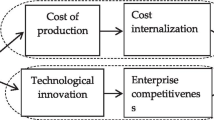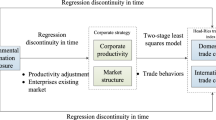Abstract
As an important environmental regulation tool, does the environmental information disclosure have the pollution haven effect and adversely affect Chinese export? Research on such topics can provide implications for Chinese policymakers to formulate realistic environmental policies and employ information disclosure environmental regulation tools to coordinate the economic-environmental development. Using the 2003–2013 Annual Survey of Industrial Firms Database and difference-in-difference identification, we examine the effect of environmental information disclosure policy on firm exports and its impacting mechanisms. The empirical results show that the Chinese environmental information disclosure policy has reduced the scale of industrial firms’ exports in the regulated regions, indicating the existence of the pollution heaven effect in China. And also, we find that this policy mainly inhibits export activities of enterprises in coastal areas. Considering enterprise heterogeneity, the policy plays an inhibitory role in the exports of the non-state-owned firms, large firms, and low-productivity firms. Furthermore, the impact mechanism test shows that corporate financing constraint and production costs are important channels for environmental information disclosure policy affecting corporate export activities. It implies that, in developing countries such as China, policymakers and enterprises need to adopt forward-looking strategies to reduce the negative influence of environmental constraints on corporate exports and coordinate environmental governance and sound development of enterprises.



Similar content being viewed by others
Notes
Source of the EID policy document: http://www.gov.cn/flfg/2007-04/20/content_589673.htm
Source of the relevant PITI reports: http://www.ipe.org.cn/reports/Reports_18336_1.html
The definition of coastal regions is derived from China Marine Statistical Yearbook.
References
Al-Tuwaijri SA, Christensen TE, Hughes Ii KE (2004) The relations among environmental disclosure, environmental performance, and economic performance: a simultaneous equations approach. Acc Organ Soc 29(5-6):447–471
Beise M, Rennings K (2005) Lead markets and regulation: a framework for analyzing the international diffusion of environmental innovations. Ecol Econ 52(1):5–17
Berman E, Bui LTM (2001) Environmental regulation and productivity: evidence from oil refineries. Rev Econ Stat 83(3):498–510
Berrone P, Fosfuri A, Gelabert L, Gomez-Mejia LR (2013) Necessity as the mother of ‘green’inventions: institutional pressures and environmental innovations. Strateg Manag J 34(8):891–909
Bertrand M, Duflo E, Mullainathan S (2004) How much should we trust differences-in-differences estimates. Q J Econ 119(1):249–275
Brandt L, Van Biesebroeck J, Zhang Y (2012) Creative accounting or creative destruction? Firm-level productivity growth in Chinese manufacturing. J Dev Econ 97(2):339–351
Cai X, Lu Y, Wu M, Yu L (2016) Does environmental regulation drive away inbound foreign direct investment? Evidence from a quasi-natural experiment in China. J Dev Econ 123:73–85
Chen Z, Kahn ME, Liu Y, Wang Z (2018a) The consequences of spatially differentiated water pollution regulation in China. J Environ Econ Manag 88:468–485
Chen YJ, Li P, Lu Y (2018b) Career concerns and multitasking local bureaucrats: evidence of a target-based performance evaluation system in China. J Dev Econ 133:84–101
Cheng Z, Li L, Liu J (2018) Industrial structure, technical progress and carbon intensity in China’s provinces. Renew Sust Energ Rev 81:2935–2946
Clarkson PM, Li Y, Pinnuck M, Richardson GD (2015) The valuation relevance of greenhouse gas emissions under the European Union carbon emissions trading scheme. Eur Account Rev 24(3):551–580
Copeland BR, Taylor MS (1995) Trade and the environment: a partial synthesis. Am J Agric Econ 77(3):765–771
Costantini V, Crespi F (2008) Environmental regulation and the export dynamics of energy technologies. Ecol Econ 66(2-3):447–460
Crinò R, Ogliari L (2017) Financial imperfections, product quality, and international trade. J Int Econ 104:63–84
Dai Y, Shi MG (2019) The impact of corporate environmental information disclosure on financial performance: empirical evidence based on listed companies in heavy polluting industries. Ecol Econ 35(06):162–169 [in Chinese]
Demailly D, Quirion P (2008) European Emission Trading Scheme and competitiveness: a case study on the iron and steel industry. Energy Econ 30(4):2009–2027
Dhaliwal DS, Li OZ, Tsang A, Yang YG (2011) Voluntary nonfinancial disclosure and the cost of equity capital: the initiation of corporate social responsibility reporting. Account Rev 86(1):59–100
Earnhart DH, Khanna M, Lyon TP (2014) Corporate environmental strategies in emerging economies. Rev Environ Econ Policy 8(2):164–185
Gao Y, Yao X, Wang W, Liu X (2019) Dynamic effect of environmental tax on export trade: Based on DSGE mode. Energ Environ 30(7): 1275–1290
Greenstone M, List JA, Syverson C (2012) The effects of environmental regulation on the competitiveness of US manufacturing. National Bureau of Economic Research, Cambridge
Hadlock CJ, Pierce JR (2010) New evidence on measuring financial constraints: moving beyond the KZ index. Rev Financ Stud 23(5):1909–1940
Hassel L, Nilsson H, Nyquist S (2005) The value relevance of environmental performance. Eur Account Rev 14(1):41–61
He Y, Tang QL (2014) Carbon disclosure, carbon performance and cost of capital. Account Res 01:79–86 [in Chinese]
Head K, Ries J (2003) Heterogeneity and the FDI versus export decision of Japanese manufacturers. J Jpn Int Econ 17(4):448–467
Healy PM, Palepu KG (2001) Information asymmetry, corporate disclosure, and the capital markets: a review of the empirical disclosure literature. J Account Econ 31(1-3):405–440
Hering L, Poncet S (2014) Environmental policy and exports: evidence from Chinese cities. J Environ Econ Manag 68(2):296–318
Jacobson LS, LaLonde RJ, Sullivan DG (1993) Earnings losses of displaced workers. Am Econ Rev 83(4):685–709
Jin G, Shen KR (2018) Is it the neighborhood as beggar or neighbor as companion? Environmental regulation implementation interaction and urban productivity growth. Manag World 34(12):43–55 [in Chinese]
Kang ZY, Zhang N, Tang XL, Liu X (2018) Does the policy of “reducing carbon” restrict the export of Chinese enterprises. China Ind Econ 09:117–135 [in Chinese]
Lu M, Qian HG (2016) An empirical study on the impact of environmental information disclosure of listed companies on financial performance. Audit Mon 05:48–51 [in Chinese]
Manova K (2012) Credit constraints, heterogeneous firms, and international trade. Rev Econ Stud 80(2):711–744
Melitz MJ (2003) The impact of trade on intra-industry reallocations and aggregate industry productivity. Econometrica 71(6):1695–1725
Mulatu A, Florax RJGM, Withagen C (2004) Environmental regulation and international trade: empirical results for Germany, the Netherlands and the US, 1977-1992. Contrib Econ Anal Policy 3(2):1–30
Oberndorfer U, Rennings K (2007) Costs and competitiveness effects of the European Union emissions trading scheme. Eur Environ 17(1):1–17
Pethig R (1976) Pollution, welfare, and environmental policy in the theory of comparative advantage. J Environ Econ Manag 2(3):160–169
Porter ME (1991) America’s green strategy. Sci Am 264(4):96
Porter ME, Van der Linde C (1995) Toward a new conception of the environment- competitiveness relationship. J Econ Perspect:97–118
Ren S, Li X, Yuan B, Li D, Chen X (2018) The effects of three types of environmental regulation on eco-efficiency: a cross-region analysis in China. J Clean Prod 173:245–255
Richardson AJ, Welker M, Hutchinson IR (1999) Managing capital market reactions to corporate social resposibility. Int J Manag Rev 1(1):17–43
Rubashkina Y, Galeotti M, Verdolini E (2015) Environmental regulation and competitiveness: empirical evidence on the Porter Hypothesis from European manufacturing sectors. Energy Policy 83:288–300
Shi X, Xu Z (2018) Environmental regulation and firm exports: evidence from the eleventh Five-Year Plan in China. J Environ Econ Manag 89:187–200
Shi BB, Feng C, Kang R (2019) Environmental information disclosure and optimization of foreign direct investment structure. China Industrial Economics 04:98–116 [in Chinese]
Shroff N, Verdi RS, Yu G (2013) Information environment and the investment decisions of multinational corporations. Account Rev 89(2):759–790
Siebert H (1977) Environmental quality and the gains from trade. Kyklos 30(4):657–673
Tang GP, Li LH (2011) Environmental information disclosure, investor confidence and corporate value: empirical evidence from listed companies in Hubei Province. J Zhongnan Univ Econ Law 06:70–77 [in Chinese]
Taylor MS (2004) Unbundling the pollution haven hypothesis. Adv Econ Anal Policy 3(2):1–26
World Bank (2007) Cost of pollution in China: economic estimates of physical damages, Washington, DC
Wu HJ (2014) Environmental information disclosure, environmental performance and equity capital cost. J Xiamen Univ (Arts Soc Sci) 03:129–138 [in Chinese]
Xu HL, Wang HC (2018) Will streamlining administration and delegating power improve export performance? A Quasi-natural experiment based on decentralization of export tax rebates. Econ Res J 53(03):157–170 [in Chinese]
You CH (2014) Environmental information disclosure, marketization process and enterprise value: empirical evidence from listed companies in China’s chemical industry. Chin Certified Public Account 02:53–57 [in Chinese]
Yu M (2014) Processing trade, tariff reductions and firm productivity: evidence from Chinese firms. Econ J 125(585):943–988
Zhang YJ, Peng YL, Ma CQ, Shen B (2017) Can environmental innovation facilitate carbon emissions reduction? Evidence from China. Energy Policy 100:18–28
Zhao X, Yin H, Zhao Y (2015) Impact of environmental regulations on the efficiency and CO2 emissions of power plants in China. Appl Energy 149:238–247
Funding
We gratefully acknowledge the financial support from the National Natural Science Foundation of China (Nos. 71673083 and 71941006).
Author information
Authors and Affiliations
Corresponding author
Additional information
Responsible editor: Nicholas Apergis
Publisher’s note
Springer Nature remains neutral with regard to jurisdictional claims in published maps and institutional affiliations.
Rights and permissions
About this article
Cite this article
Fang, J., Liu, C. & Gao, C. The impact of environmental regulation on firm exports: evidence from environmental information disclosure policy in China. Environ Sci Pollut Res 26, 37101–37113 (2019). https://doi.org/10.1007/s11356-019-06807-2
Received:
Accepted:
Published:
Issue Date:
DOI: https://doi.org/10.1007/s11356-019-06807-2




